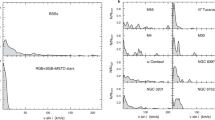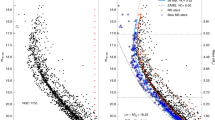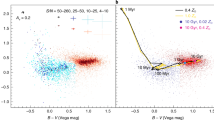Abstract
Blue stragglers in globular clusters are abnormally massive stars that should have evolved off the stellar main sequence long ago. There are two known processes that can create these objects: direct stellar collisions1 and binary evolution2. However, the relative importance of these processes has remained unclear. In particular, the total number of blue stragglers found in a given cluster does not seem to correlate with the predicted collision rate3,4, providing indirect support for the binary-evolution model. Yet the radial distributions of blue stragglers in many clusters are bimodal, with a dominant central peak5,6,7: this has been interpreted as an indication that collisions do dominate blue straggler production, at least in the high-density cluster cores7,8. Here we report that there is a clear, but sublinear, correlation between the number of blue stragglers found in a cluster core and the total stellar mass contained within it. From this we conclude that most blue stragglers, even those found in cluster cores, come from binary systems. The parent binaries, however, may themselves have been affected by dynamical encounters. This may be the key to reconciling all of the seemingly conflicting results found to date.
This is a preview of subscription content, access via your institution
Access options
Subscribe to this journal
Receive 51 print issues and online access
$199.00 per year
only $3.90 per issue
Buy this article
- Purchase on Springer Link
- Instant access to full article PDF
Prices may be subject to local taxes which are calculated during checkout


 to the observed blue straggler number.
to the observed blue straggler number.

Similar content being viewed by others
References
Hills, J. G. & Day, C. A. Stellar collisions in globular clusters. Astrophys. Lett. 17, 87–93 (1976)
McCrea, W. H. Extended main-sequence of some stellar clusters. Mon. Not. R. Astron. Soc. 128, 147–155 (1964)
Piotto, G. et al. Relative frequencies of blue stragglers in galactic globular clusters: Constraints for the formation mechanisms. Astrophys. J. 604, L109–L112 (2004)
Leigh, N., Sills, A. & Knigge, C. Where the blue stragglers roam: Searching for a link between formation and environment. Astrophys. J. 661, 210–221 (2007); erratum 678, 564–566 (2008)
Ferraro, F. R. et al. Blue stragglers in the Galactic globular clusters M3: Evidence for two populations. Astron. J. 106, 2324–2334 (1993)
Ferraro, F. R. et al. Discovery of another peculiar radial distribution of blue stragglers in globular clusters: The case of 47 Tucanae. Astrophys. J. 603, 127–134 (2004)
Mapelli, M. et al. The radial distribution of blue straggler stars and the nature of their progenitors. Mon. Not. R. Astron. Soc. 373, 361–368 (2006)
Mapelli, M. et al. The contribution of primordial binaries to the blue straggler population in 47 Tucanae. Astrophys. J. 605, L29–L32 (2004)
Benz, W. & Hills, J. G. Three-dimensional hydrodynamical simulations of stellar collisions. I - Equal-mass main-sequence stars. Astrophys. J. 323, 614–628 (1987)
Leonard, P. J. T. & Livio, M. The rotational rates of blue stragglers produced by physical stellar collisions. Astrophys. J. 447, L121–L123 (1995)
Sills, A. P., Bailyn, C. D. & Demarque, P. Are blue stragglers mixed during collisions? Astrophys. J. 455, L163–L165 (1995)
Sandquist, E. L., Bolte, M. & Hernquist, L. Composition mixing during blue straggler formation and evolution. Astrophys. J. 477, 335–345 (1997)
Sills, A. & Bailyn, C. D. The distribution of collisionally induced blue stragglers in the color-magnitude diagram. Astrophys. J. 513, 428–441 (1999)
Ferraro, F. R. et al. Discovery of carbon/oxygen-depleted blue straggler stars in 47 Tucanae: The chemical signature of a mass transfer formation process. Astrophys. J. 647, L53–L56 (2006)
Piotto, G. et al. HST color-magnitude diagrams of 74 galactic globular clusters in the HST F439W and F555W bands. Astron. Astrophys. 391, 945–965 (2002)
Sollima, A., Beccari, G., Ferraro, F. R., Fusi Pecci, F. & Sarajedini, A. The fraction of binary systems in the core of 13 low-density Galactic globular clusters. Mon. Not. R. Astron. Soc. 380, 781–791 (2007)
Milone, A. P., Piotto, G., Bedin, L. R. & Sarajedini, A. in XXI Century Challenges for Stellar Evolution (eds Cassisi, S & Salaris, M.) 623–627 (Società Astronomica Italiana, 2008)
Sollima, A., Lanzoni, B., Beccari, G., Ferraro, F. R. & Fusi Pecci, F. The correlation between blue straggler and binary fractions in the core of Galactic globular clusters. Astron. Astrophys. 481, 701–704 (2008)
Davies, M. B., Piotto, G. & de Angeli, F. Blue straggler production in globular clusters. Mon. Not. R. Astron. Soc. 349, 129–134 (2004)
Knigge, C. et al. A blue straggler binary with three progenitors in the core of a globular cluster? Astrophys. J. 641, 281–287 (2006)
Knigge, C. et al. Stellar exotica in 47 Tucanae. Astrophys. J. 683, 1006–1030 (2008)
Gehrels, N. Confidence limits for small numbers of events in astrophysical data. Astrophys. J. 303, 336–346 (1986)
Leonard, P. J. T. Stellar collisions in globular clusters and the blue straggler problem. Astron. J. 98, 217–226 (1989)
Harris, W. E. A catalog of parameters for globular clusters in the Milky Way. Astron. J. 112, 1487–1488 (1996)
McLaughlin, D. E. & van der Marel, R. P. Resolved massive star clusters in the Milky Way and its satellites: Brightness profiles and a catalog of fundamental parameters. Astrophys. J. Suppl. Ser. 161, 304–360 (2005)
Pryor, C. & Meylan, G. in Structure and Dynamics of Globular Clusters (eds Djorgovski, S. G. & Meylan, G.) 357–371 (Astronomical Society of the Pacific, 1993)
Webbink, R. F. in Dynamics of Star Clusters (eds Goodman, J. & Hut, P.) 541–577 (Reidel, 1985)
Sills, A. et al. Evolution of stellar collision products in globular clusters. I. Head-on collisions. Astrophys. J. 487, 290–303 (1997)
Sills, A., Faber, J. A., Lombardi, J. C., Rasio, F. A. & Warren, A. R. Evolution of stellar collision products in globular clusters. II. Off-axis collisions. Astrophys. J. 548, 323–334 (2001)
Verbunt, F. W. M. Observational evidence for origin of stellar exotica in globular clusters. Highlights Astron. 14, 440–441 (2007)
Acknowledgements
Research support for C.K. was provided by the UK Science and Technology Facilities Council. A.S. and N.L. are supported by the Natural Sciences and Engineering Research Council of Canada. C.K. would like to thank T. Maccarone for discussions.
Author information
Authors and Affiliations
Corresponding author
Rights and permissions
About this article
Cite this article
Knigge, C., Leigh, N. & Sills, A. A binary origin for ‘blue stragglers’ in globular clusters. Nature 457, 288–290 (2009). https://doi.org/10.1038/nature07635
Received:
Accepted:
Issue Date:
DOI: https://doi.org/10.1038/nature07635
This article is cited by
-
UVIT study of UV bright stars in the globular cluster NGC 4147
Journal of Astrophysics and Astronomy (2021)
-
The “dynamical clock”: dating the internal dynamical evolution of star clusters with Blue Straggler Stars
Rendiconti Lincei. Scienze Fisiche e Naturali (2020)
-
Dynamical age differences among coeval star clusters as revealed by blue stragglers
Nature (2012)
-
A mass transfer origin for blue stragglers in NGC 188 as revealed by half-solar-mass companions
Nature (2011)
-
Two distinct sequences of blue straggler stars in the globular cluster M 30
Nature (2009)
Comments
By submitting a comment you agree to abide by our Terms and Community Guidelines. If you find something abusive or that does not comply with our terms or guidelines please flag it as inappropriate.



